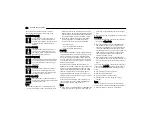
more room or straighten out the trailer, and shift back
to REVERSE without the need to reactivate the feature.
The feature will cancel after 30 seconds in DRIVE or
when the vehicle speed reaches 8 mph (12 km/h).
To cancel out of the feature, come to a stop and shift to
PARK, or push the TRSC activation button.
Instrument Cluster Messages:
●
“Calibrate Trailer
” will display when a trailer is
not calibrated and the vehicle is at a standstill while
the button is pushed.
●
“Calibrating Trailer” will display when the trailer is
not calibrated and the vehicle is moving while the
button is pushed.
●
“To Activate Trailer Steering Shift To P” will display
when the trailer is calibrated successfully, the TRSC
activation button is pushed and the vehicle is not in
PARK.
●
“Trailer Steering Ready, Shift To Reverse” will display
when the button is pushed, trailer is calibrated and
the vehicle is in PARK.
●
“Trailer Steering Active” will display after the driver
shifts to REVERSE and indicates the feature is
active.
●
“Trailer Steering Unavailable” will display if there is a
fault in the system preventing activation, the driver’s
door is open, the driver’s seat belt is unbuckled, or
the tailgate is open.
Other reasons the feature may cancel:
●
The driver overrides steering by placing hands on the
steering wheel.
●
Trailer tracking is lost.
●
If the trailer angle becomes excessive, the brakes
apply bringing the vehicle to a stop and then
applying the parking brake.
●
Trailer steering button is pushed while active.
●
Vehicle speed goes over 8 mph (12 km/h).
●
Driver door is open and seat belt is unbuckled.
●
Transmission shifted to PARK.
Trailer Memory
The trailer steering system will automatically retain the
calibration of the previous five trailers connected, so
recalibration will not be necessary when hooking up.
The next time the vehicle is started, place the vehicle in
DRIVE and drive a short distance. The TRSC system can
then be activated.
NOTE:
Trailers may look different during day and night
conditions. In such cases, the trailer may need to
recalibrate.
Some trailers (such as boat trailers) will need to
recalibrate while loaded and unloaded.
NOTE:
●
The system may not detect a trailer in low light
conditions. In sunny conditions, the performance
may be degraded as shadows pass over the trailer.
●
The driver is always responsible for safe operation of
truck and trailer.
●
The driver is always in control of the truck as well
as the trailer and is responsible for controlling the
throttle and brakes.
●
The system may not function when the camera lens
is blocked, blurred (covered with water, snow, ice,
dirt, etc) and will not work unless the tailgate is
upright and fully latched.
T
OWING
R
EQUIREMENTS
To promote proper break-in of your new vehicle
drivetrain components, the following guidelines are
recommended.
CAUTION!
●
Do not tow a trailer at all during the first 500 miles
(805 km) the new vehicle is driven. The engine,
axle or other parts could be damaged.
●
Then, during the first 500 miles (805 km) that
a trailer is towed, do not drive over 50 mph (80
km/h) and do not make starts at full throttle. This
helps the engine and other parts of the vehicle
wear in at the heavier loads.
Perform the maintenance listed in the Scheduled
Servicing section for the proper maintenance intervals
. When towing a trailer, never exceed the
GAWR or GCWR ratings.
WARNING!
Improper towing can lead to a collision. Follow these
guidelines to make your trailer towing as safe as
possible:
●
Make certain that the load is secured in the trailer
and will not shift during travel. When trailering
cargo that is not fully secured, dynamic load shifts
can occur that may be difficult for the driver to
(Continued)
192 STARTING AND OPERATING







































